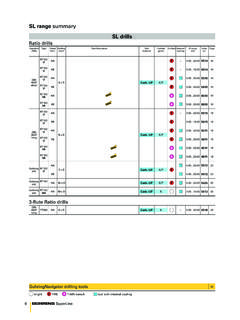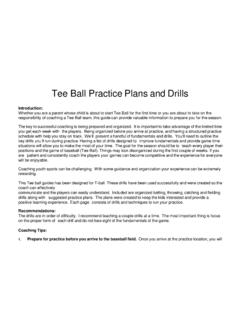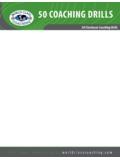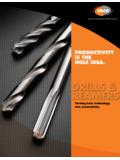Transcription of Field Hockey Drills and Practice Plans
1 Field Hockey Drills and Practice Plans Making you a better coach one Practice at a time! 2006 All Rights Reserved Table of Contents How to use this Guide 3. Ball Control Drills 5. Passing, Shooting and Attacking 15. Offense and Defense drill and Tactics 25. Practice Plans 35. -2 . Field Hockey Drills and Practice Plans 2006 All Rights Reserved How to Use this Guide Introduction How to Use this book! Field Hockey coaches are constantly on the lookout for Drills and skills that are going to make their players better. Further, being able to put those Drills together with a Practice plan to reinforce those skills makes it all the more effective. That's going to be the goal of this guide. Practice makes perfect We have all heard that saying, and it really is true. Repetition of skills is the best way to get your players to perform better. Knowing what to do when the opportunity presents itself is one of the hallmarks of a good player.
2 The more Practice , the more inclined your players are to do the right thing at the right time. Skill development in essential to having a good Field Hockey team. Practicing the Drills included in this book are going to help your players continue to develop their playing habits and improve their overall skill level. We have divided this book into three different skill areas that you can focus on: Ball Control Drills Passing, Shooting and Attacking Offensive and Defensive Drills and tactics The Drills included in this book will range in skill / age level based on their difficulty. Some of the more advanced Drills you certainly aren't going to use for the younger ages. Likewise, the more basic skills, like the basics of passing and shooting the ball, you aren't going to be teaching those to your older, more experienced players. Each drill 's skill level will be denoted by the following symbols: Beginner: Intermediate: -3.
3 Field Hockey Drills and Practice Plans 2006 All Rights Reserved Advanced: Planning practices After you have a few more Drills under your belt, it is important to structure those Drills into an effective Practice . We will also include 25 different Practice Plans to use throughout a season. Each of these Practice Plans will be geared towards a specific skill or set of skills and each will continue to build off one another. You don't have to use all of the Practice Plans ! We have included several different ones so you can choose the ones that work best for you and your team. As a coach, you will probably only choose the ones where your team needs the most attention. With our Practice Plans , you can simply print the ones you want off your computer and you will be ready to go! Ready to go! The first section of this book will be the various Drills , divided into three separate sections. Then you will notice those Drills included in the Practice Plans we have provided for you in the second half of the book.
4 Once you have gone through this book, you will be armed with a number of great Drills and an idea of how to implement them for your team! Then, you watch as their skills get better and you become more confident as a coach! Best of luck! -4 . Field Hockey Drills and Practice Plans 2006 All Rights Reserved Ball Control Drills The Control Zone This is the first step to teaching younger players the proper stance when controlling the ball. What you need Each player should have a stick and a ball to do this exercise. How this drill works In order to learn to proper distance the ball should be away from the player for optimum control, the ball will be dropped from the person's hand. The players take a regular stance, with their feet just over shoulder width apart, and hold out their left hand directly in front of them. With a slight lean forward the player should then drop the ball in front of them. At this point, the player should grab the stick in the proper form, and address the ball.
5 This should be the proper point that a player must learn to handle the ball, pass the ball and shoot the ball. This is called the control zone. Result A player is going to understand their control area. Stealing the Bacon Racing to the ball and then keeping control of it are an important element of Field Hockey . What you need In groups of six, divide them into teams of three. One team will line up on the 25 yard line, and the other team on the 50 yard line and they are facing each other. The coach puts the ball in the absolute middle between the two teams and then blows the whistle. Two pylons are placed about 10 yards apart on both the 25 and 50-yard lines. Members of the two sides sprint towards the ball (using the proper footwork to approach the ball), and the first side to get it goes on offense and the other side on defense. The team on offense tries to control the ball long enough to dribble it between the other side's pylons.
6 Result This is a good game for control and position when handling the ball. -5 . Field Hockey Drills and Practice Plans 2006 All Rights Reserved Controlled, Loose and Indian This drill teaches a player the three main kinds of dribbling. What you need Set up a pylon course where players can learn each of the different dribbling styles. You can set this drill up with three different stations, and at each station the players work on each type of dribbling. How this drill works At each station, the players will work on controlling the ball with the three main types of dribbling: controlled, loose (speed dribble), and Indian dribble. The controlled dribble is used to keep the ball in tight to the body, so the player can maneuver in tight spaces. The loose, or speed dribble, is used when a player is in the open, and they need to breakout quickly. Players should try to do this dribble with only one hand on the stick and the other used to pump the arms for running.
7 The Indian dribble is a diagonal dribble that helps you pull and push the ball from front right to close left (or the opposite, depending on the dribble). Result Dribbling around the pylons is going to help the players learn to control the ball no matter how they have to dribble. Dodge drill Dodges are quick fakes that help a player in control of the ball, elude the defense. What you need Pair up players of similar skill, and give them one ball between the two of them. How this drill works The first player will start and control the ball using the various types of dribbles learned in the above drill . Along with that, the controlling player will use dodges juke techniques to avoid defenders. The goal with each dodge' or fake is to get the defender to commit to the direction your player fakes, in order to dribble the ball around them. Result Matching ball control with the ability to dodge is going to make your players more effective on offense.
8 It will also give defenders the chance to learn dodge defense. -6 . Field Hockey Drills and Practice Plans 2006 All Rights Reserved Change speed, change direction This is another drill to help players with basic ball control and dodges What you need Line up three pylons in a straight line, about 5 to 7 yards apart (see diagram below). Set up more than one station. Groups line up at each pylon station. How this drill works The player will start this drill dribbling the ball ahead of them, and upon reach the first pylon they will dodge, change speed and then go the other way. Then go to the next cone. As players gain confidence and experience, they can start developing their own change of pace to elude defenders. Once player get a little more experienced, replace the pylons with passive defenders. Result More work on ball control and eluding defenders. Pull Back drill The pull back helps a player slow down the play and regain close control of the ball.
9 What you need Create three lines of players and place three cones 10 yards in front of them. Each line has a ball. How this drill works When the coach blows the whistle the players from each line will sprint towards the cone with the speed dribble. About 3 yards away from the cone (can be marked off), the player must break down and reach out for the ball and pull it back toward them. After more experience is gained, change the pylons to real defenders. Result Pull back skill will be practiced and perfected. -7 . Field Hockey Drills and Practice Plans 2006 All Rights Reserved Combo Dribble Dodge drill Helps put players into a game-like' situation with different consecutive movements. What you need See diagram below How this drill works Instead of the basic drill where players are just working on single dribbling maneuvers, this one combines the different dribbles into one drill . When the player starts out, they speed dribble, dodge, then control dribble, dodge, then Indian dribble, pull back, then speed dribble past the final cone.
10 Result This drill will help players with all facets of ball control, and executing maneuvers in succession. Dodge and slide Getting the body in the way after a dodge is key in keeping control of the ball What you need See diagram below How this drill works This is another ball control variation of previous Drills . However, in this one, after each dodge, the player shuffles (slides) in front of the pylon. This simulates getting the body back in front of the defender to prevent them from reaching for the ball. As players get more experience, change from pylons to defenders. Result One more basic skill is added to your players' ball control. -8 . Field Hockey Drills and Practice Plans 2006 All Rights Reserved Cone Weave This drill will help players control the ball in tighter situations What you need See diagram below. Run this with two or more stations. How this drill works As you can see from the diagram, this is a straight ahead ball control drill as the player negotiates their way through the course.





